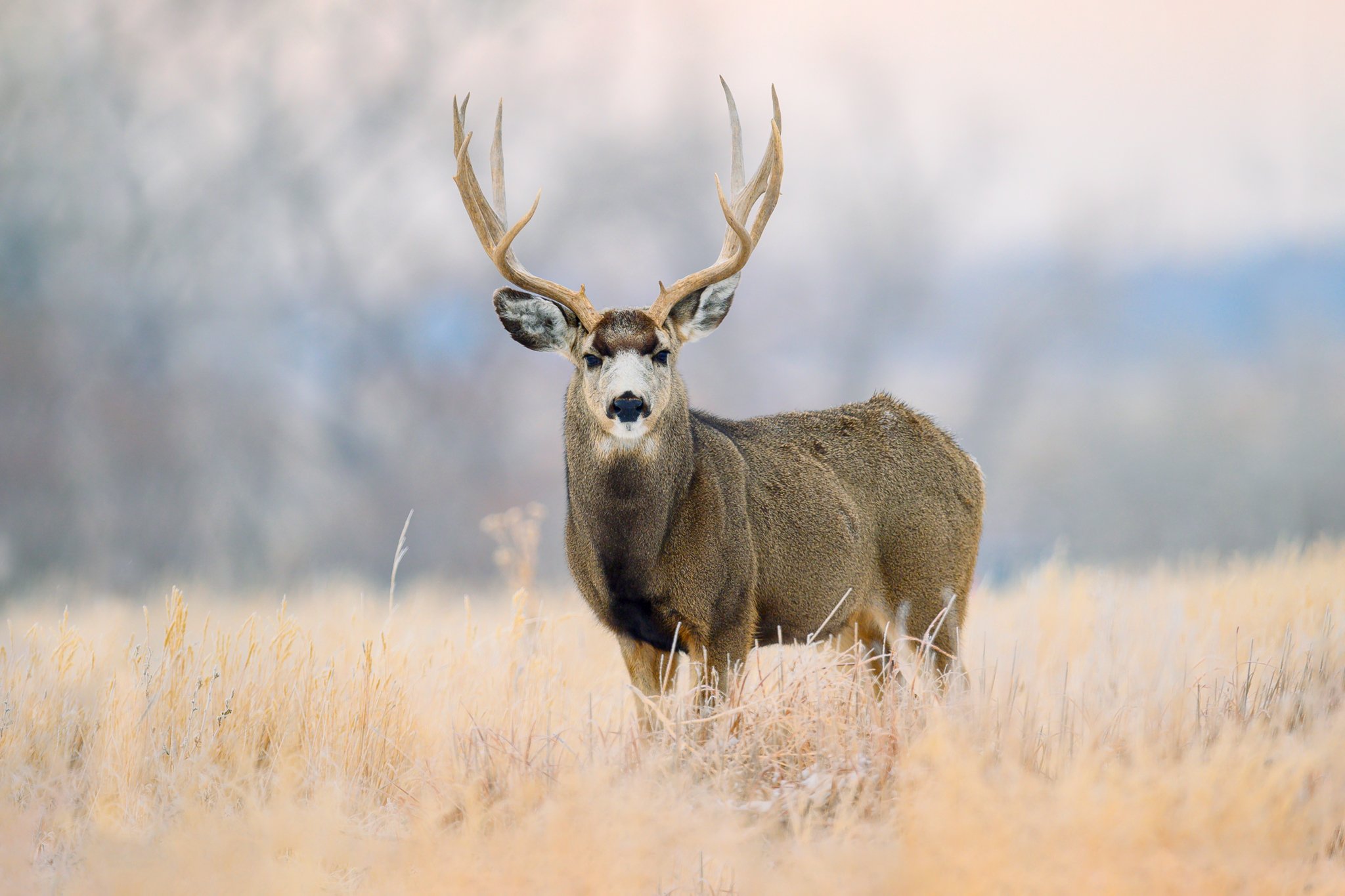Chasing the Rut pt 7
It’s tough to confuse a mule deer with a whitetail. Mulies, as we like to call them out here, look completely different. They are bigger in size, the bucks often sport white colored faces like an aging dog, and their antlers often confuse tourists who mistake them for elk whose structure branches endlessly instead of being designed around one primary tine like that of a whitetail’s. And their ears, oh those giant ears for which their name is derived – these are their superpower. As the saying goes, anything that happens in the mountains the eagle will see, the bear will smell, and the deer will hear.
But as elephants have taught us, big ears aren’t just about having better hearing. Those oversized ears likely play a bigger role in mule deer biology.
Mule deer occupy a similar habitat as bison and pronghorn. These are a species of open areas, adapted for heat and cold, landscapes that stretch on, uninterrupted, to the horizon at times, in a seemingly endless sea of grass. Prairies are a landscape of extremes. In the summer, temperatures can easily rise above 110 degrees. And in the winter, it can drop to minus 40 degrees. This means that any large animal who survives in this habitat must be able to handle a 150-degree Fahrenheit temperature swing through the year.
Pronghorn and bison have adapted to this by evolving a highly developed hypothalamus for helping to cool down the brain. This is why, when traveling to a place like Grand Teton or Yellowstone National Park, pronghorn and bison are the only species you typically find mulling about after 10am in the summer months. All the other denizens have retreated to the shade of the forests. The mule deer, researchers believe, are able to join the midday party because they use their large ears to help cool down their blood much the way an elephant or jackrabbit does. These ears are full of tiny arteries and blood vessels. By being exposed to the air and what bit of breeze there may be, the blood is cooled down before returning to the interior of the body.
We have already discussed the concept of Bergman’s Rule in this series, but there is another so called rule that is applicable here. This one is called Allan’s Rule. Allan’s Rule states that the further north a subject lives, the shorter the appendages of their body become such as legs and ears.
The idea here is that cold weather makes for tighter more compact appendages where heat loss is most prevalent. Think of it this way: when you are out in the cold, what parts of your body turn red and start to sting first? Your feet, your fingers, your ears, your nose. This is why an artic fox has short stubby legs and tiny ears compared to their lanky and big eared kit fox cousins of the southwest. Likewise, this is one of the key reasons why elephants have such large ears as it helps them maintain their body temperature despite carrying around 13,000 lbs. of mass in all that heat.
How then do we explain the nature of a mule deer’s ears given that this species ranges from Mexico to southern Alaska?
If you have spent time observing and photographing mule deer in the more northern latitudes, you may have noticed that many of them have split or notched ears. This was not a genetic trait. Instead, it’s the result of frostbite and wounds from extreme cold.
At first glance, this is somewhat odd. Here is a species that lives all across the intermountain west and up into northern Canada. Why would these animals not be better adapted to the cold then?
While whitetail deer are considered to the be the “oldest” deer species in the world, having existed in their current state for around 4 million years now. Mule deer, however, are in fact the “youngest” species of deer on Earth. Mule deer pop up in the fossil record only about 10,000 years ago after the great Pleistocene extinctions across North America. And many researchers believe that the mule deer is the product of hybridization between the coastal black tail deer and the whitetail. As the story goes, those species that survived the big event that killed everything from saber tooth cats to tiny field mice, spread out and multiplied quickly – moving into new regions they were once kept out of by others occupying a similar niche or simple predation. With the likes of dire wolves, short-faced bears, the American cheetah, American lion, and those saber tooth cats I mentioned now gone from the landscape, those species that managed to survive exploded in population.
While racist ideologies that sprang up after Charles Darwin’s On the Origin of Species still plague our society and its perception of “mixing species,” this concept of hybridization is nothing special in the real world. It’s likely that every species on the planet is a hybrid of at least a couple different similar organisms. You yourself likely harbor the genes of 4 distinct species, for instance: modern humans, Neanderthals, Denisovans, and a fourth species yet to be described but whose mark on our genome is now unmistakable.
So, for the mule deer, a relatively newcomer on this planet, evolution is still hard at work on these animals as they continue to adapt to new habitat they have only recently begun to occupy.
Ironically, we too are likely the product of major cataclysms and disasters. When we look at our own genetic diversity, we realize our species passed through a genetic bottleneck roughly 75,000 years ago. Many attribute this to the Toba super-volcano that erupted around that same time which happens to be one of the largest known volcanic events to have occurred, resulting in 10 years of “nuclear winter” followed by a thousand years of global cooling. But whatever was the cause, modern humans almost went extinct around this time. What came out the other side of that bottleneck was quite different than what went. Although anatomically we are about the same, it was only around this time that suddenly art and complex material culture quite literally explodes upon the scene. Those that survived were the cleverest and most creative, and they passed those genes on to offspring. Today, every male human on the planet can trace a single genetic mutation on the Y chromosome that originated around that time back to the San people of the Kalahari Desert – a sort of genetic Adam, if you well.
Whereas whitetail deer tend towards maintaining citizenship of forests, even as they have moved into the vast and open western landscape, mule deer are most comfortable in the rolling prairie of the Rocky Mountain steppes and the high mountain landscapes. It is not uncommon to find mulies traversing subalpine meadows with bighorn sheep, or working their way across rocky scree. Though their ears are one of the defining characteristics of this species, they tend toward a landscape where one can only assume that their eyes must play just as important of a role as their ability to hear.
Much like elk in the Canadian Rockies, mule deer appear to heavily benefit from regions that were recently bulldozed by glaciers. Minerals and protein play tremendous roles in the production of antlers and horns (they are different), and glacial till holds a never-ending supply of exactly what these mule deer desire. In other words, my experience has thus far suggested that where I find the biggest antlers on elk, I also find the biggest antlers on mule deer as well.
Similar to whitetails, mule deer hit the peak of their rut, statistically speaking, on November 9th. However, you will find solid rutting behavior throughout the entire month. And I tend to spend my time working with these animals on the backside of Thanksgiving.
Like everything in wildlife photography, you end up with two very different camps of photographs: portraits and landscapes. When it comes to photographing mule deer, I travel to different places for different photographic concepts. When I want closeup portraits of big mule deer, I go one place. When I want sweeping environmental photographs, I go someplace else. Each experience is different for me as a visual storyteller. Although mule deer can be found across the west, I have only two places that I suggest traveling to.
Locations . . .
Rocky Mountain Arsenal National Wildlife Refuge. Denver, Colorado
After reading about whitetail deer, you probably saw this one coming. For portraits of gigantic mule deer during the rut, I really know of no other public place that can compete with this location.
The Arsenal contains an 11-mile loop “wildlife drive” much like Cades Cove in the Smoky Mountains. There are several short roads running here and there through the refuge, and all of these can produce giant mule deer.
Given its location right next to Denver, this is a very easy wildlife photography destination to fly into and work. Hotels abound and can be found relatively close to the Arsenal. This place also has the added benefit of not requiring four-wheel or all-wheel drive vehicle with high clearance – unlike the next place on the list.
Dubois, Wyoming
Dubois is the antithesis of the Arsenal. Whereas my other mule deer location could not be more conveniently located and easily accessed, Dubois is anything but that. If you fly in for this place, you can do so to Jackson Hole, Wyoming ($$$) or Riverton, Wyoming. Neither are close. You will need a high clearance 4x4 vehicle and you will need a good 1.5 – 2 hours of driving to get to the town. Come November, snowstorms and blizzards are common in this part of the country, and I have spent days in 50mph winds blowing down out of the Wind River Range that created wind chills in the minus 50s here.
Despite all the reasons that one may think twice about traveling here for photography, this is hands down one of my favorite places to photograph. It’s wild. It’s rugged. The whole of the place is practically dripping with Shoshone petroglyphs and the landscapes are spectacular.
There are many locations around the town of Dubois where you can find and photograph mule deer. The two best places though are the painted desert to the north and the Ring Lake area to the south. The landscapes could not be more different.
I prefer spending the bulk of my time around Ring Lake area on BLM land and traveling up high on the 4x4 only dirt roads to capture images with the painted desert in the background down below.
And best of all, if you plan your trip as late into November as possible you can also catch the bighorn sheep rut.

